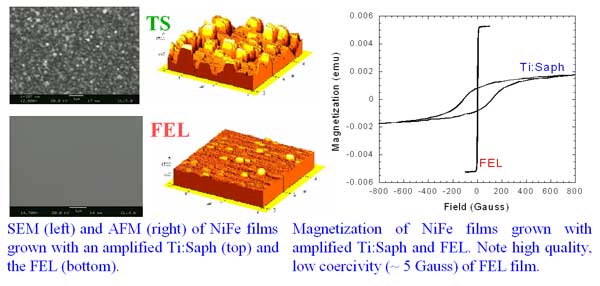Pulsed Laser Deposition – Magnetic thin films
Additional Links
Well-behaved magnetic thin films of stoichiometric alloys, such as an alloy of nickel and iron (NiFe), are not easily formed. Anne Reilly and colleagues at Jefferson Lab and The College of William & Mary excited bulk NiFe with the Jefferson Lab FEL and found a strikingly different response than that found with a conventional titanium-sapphire laser.
The Jefferson Lab FEL caused a plume to be emitted when it struck the bulk material, similar to what happened with the conventional laser. However, the spectrum of this plume indicated that the atoms were in a thermally, but not electronically, excited state, as judged by the broadband thermal emission spectrum.
The thin films formed when these plumes condensed onto substrates also showed striking differences, as shown in the figure. Furthermore, the measured hysteresis of the Jefferson Lab FEL produced smoother films, matching that of the native material, whereas the films produced conventionally were dramatically different and very lossy. These experiments demonstrate the high potential for a laser with a high repetition rate to produce materials in novel forms for technological developments in energy, data storage, and in testing dynamical theories of material behavior far from equilibrium and under extreme conditions.
Reference:
A. Reilly et al. J. Appl. Phys. 95 3098 (2003)


